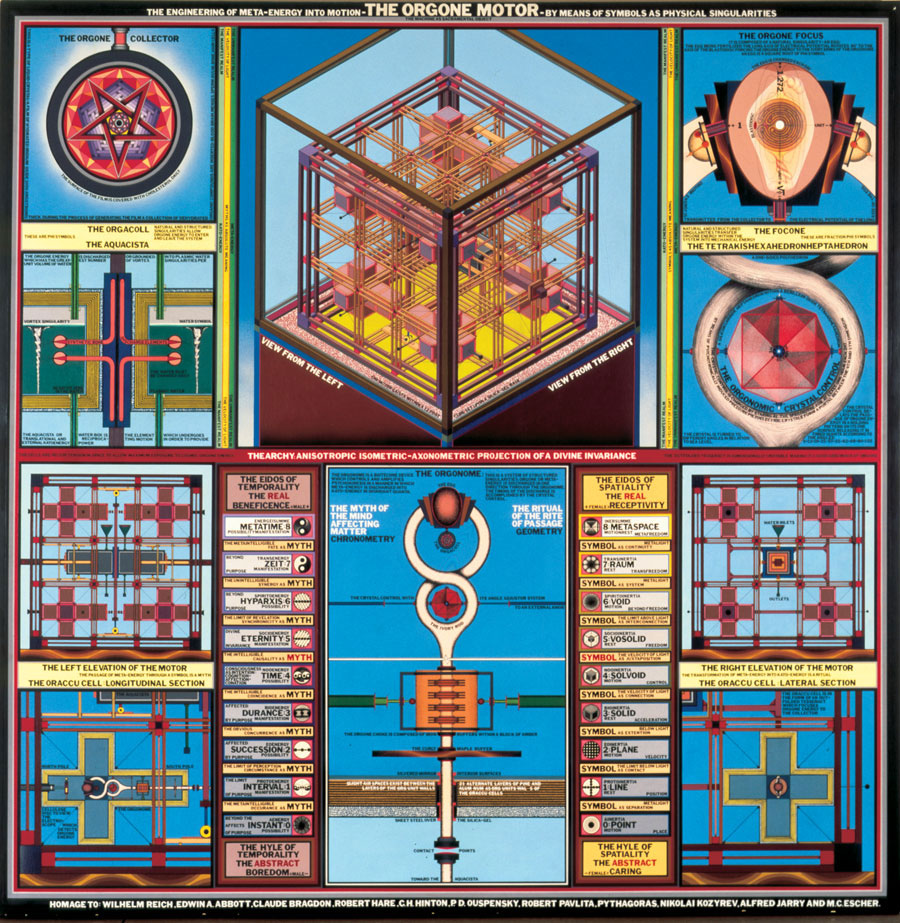Begin the Bauhauroque
Paul Laffoley’s paintings of time machines, prayer devices, and maps of the cosmos take inspiration from such sources as Samuel Taylor Coleridge and his own encounters with UFOs.

Interview by Nozlee Samadzadeh
How does your training as an architect influence your paintings?
I’ve been painting since I was four years old and my father hated that. My mother kept saying, “Well, he should get into something where he can make some money.” So he sent me to architecture school. It wasn’t bad. I liked it as long as I was able to stay there, but eventually they just kicked me out. Continue reading ↓
All images used with permission, © copyright Paul Laffoley, all rights reserved.








Interview continued
What kind of research, writing or thinking do you do before beginning a painting? How does that relate to your architectural training?
I think most research is the same thing. You have some kind of vague notion of something and then try to find references to it or things about it. And as you research as you go along, suddenly stuff starts accumulating.
There’s a piece of yours, the “Geochronmecane,” that outlines a plan for a time machine. Why do you think we have a right or a duty to be traveling in time and space? Is it just for fun?
That was exactly what people said when the Wright Brothers were trying to make an airplane: “It’s not natural for humans to fly,” you know for maybe 50 years prior to this!
You were recently chosen for a Guggenheim fellowship, for which you’ll be concentrating on the conceptualization of the “Bauhauroque.” What is that, and when did it begin?
Yes, I’m going to do six six-foot paintings about it. I started to realize that if you came down and then you start back up, you can figure out how long different periods of history lasted. You know, going from the time of the Egyptians to 1790. Now if 1790 is the bottom, it’s going to start back up. And that was Neoclassicism, then you get Romanticism and Realism, then you go right into Modernism and then, around 1972, you get Postmodernism. Then I said, “OK, if you’ve got Modernism and Postmodernism, what the hell is next?” Well, it’s got to be named another thing because of people who would try to name it, like Ada Louise Huxtable, “Post-Postmodernism.” Well, that’s cultural stuttering!
Now back to the Renaissance, you get to Baroque theory. They went back and started dealing with the High Gothic, with the engineering to do the types of buildings that they did—Bernini, you know, really crazy stuff. So when Modernism came along, the architects just eschewed anything to do with the 19th century, which was known very much for its engineering. I mean, I studied personally, in earnest with one of these guys, who just thought that anything to do with the 19th century was nothing. And so, what I thought was that if you went back and took the 19th century, there were mega engineering ideas that you could get to work with the Baroque—so it’s a combination of the Bauhaus and the Baroque, it comes out a new word and therefore gives people the idea that there’s some new sensibility going on. And so in terms of the Bauhauroque, at first, years before, I had it set at 2000. And then of course when they blew up the World Trade Center, I said, that’s the date the Bauhauroque began—September 11, 2001.
You see your work as having these esoteric components that enhance one’s psychological powers in various ways—if only one reads the work correctly, one might see the future. Do you see art as generally having this mind-channeling component or is specific to the type of art that you do?
Why not? People have got to get over this nonsense that you’ve got to have mystery in your life. Well, you’re never not going to be a mystery no matter what you do. Things keep opening up; science keeps opening up and art keeps opening up.
Why so many references to religion and religious experience?
Oh, I’m a Roman Catholic, I don’t know. [laughs] I think more of my influence is my father, who was a trans-medium. He knew all this stuff from the 19th century. You know, Madam Blavatsky, the People’s Society, that kind of stuff.
I don’t think my religious background influenced anything at all. It was just something that I was forced to do on a Sunday. My father didn’t believe in gravity. I got into a lot of trouble because of that one, too.
You’re not a scientist by trade, but you use a lot of scientific vocabulary and concepts in your art. By the same token, theoretical physicists often use an almost artistic, fanciful vocabulary in describing their work. What’s happened to our vocabulary that science and art can meld in this way?
They attract each other. They’re caught where, for instance, art has a history that goes back to the cave people. The thing that we call art is so old that you really can’t know its origin, whereas science began years ago. So it all seems primitive in relation to art; the ideas of science help feed the art that I have to give. Because art is always fit for any ideas that people have.
It’s something that people are interested in; it’s a way to bring the audience into it. But usually people contemplate art because they think that’s what it’s all about. Why would you want it other than to contemplate? Unless you’re an enormous name and you’re in major museums, people aren’t going to pay attention. They’d rather go out and buy some shoes because their artistic drive is satisfied by that. So if you’ve got a big name, people are attracted to the name and then they associate the image with that name and they think they’re good.
